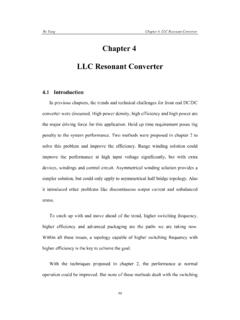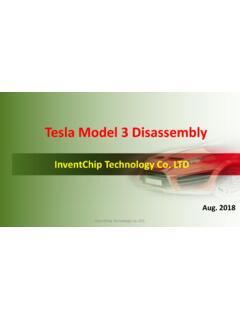Transcription of Survey of Resonant Converter Topologies
1 Power Supply Design SeminarSurvey of Resonant Converter TopologiesReproduced from2018 Texas Instruments Power Supply Design Seminar SEM2300, Topic 1TI Literature Number: SLUP376 2018 Texas Instruments IncorporatedPower Supply Design Seminar resources are available 11-1 Survey of Resonant Converter TopologiesSheng-Yang Yu, Runruo Chen and Ananthakrishnan ViswanathanAbstrActStarting with 2- and 3-element Resonant topology fundamentals, this session walks through the key charac-teristics, analysis methodology, control challenges and design considerations of Resonant Topologies . Three design examples demonstrate Resonant topology performance with high switching frequency (~1 MHz) or with wide output voltage regulation range (2 to 1 output voltage regulation level). This session also intro-duces a new Resonant topology structure, the CLL Resonant Converter , with size and efficiency advantages over the traditional LLC series Resonant Converter .
2 Finally, this session provides guidance on how to select the best Resonant topology for various IntroductIonIn recent years, Resonant converters have become more popular and are widely applied in various applications like server, telecom and consumer electronics. One key attractive characteristic is that a Resonant Converter can easily achieve high efficiency and allow high frequency operation with their intrinsic wide soft-switching ranges. In addition, magnetic integration, for example, utilizing transformer magnetizing and leakage inductors as two Resonant elements, is possible in some Resonant converters and allows low component count and cost. However, Resonant converters rely on frequency modulation (FM) to achieve voltage or current regulation instead of traditional pulse width modulation (PWM).
3 Therefore, the input-to-output voltage gain of a Resonant Converter can no longer be derived from the inductor volt-second balance like PWM converters and becomes much more complex than a PWM Converter . The complicated input-to-output voltage relation can affect the decision-making process when selecting Converter paper aims to provide the audience with a thorough understanding of Resonant converters and ease concerns related to the control technique and analytical complexity. Starting from Resonant Converter fundamentals, this paper walks through the key characteristics, analysis methodology, control challenges and design considerations of Resonant converters. A simple and commonly used analysis method for Resonant converters, fundamental harmonic analysis (FHA), is introduced along with a classical Resonant Converter structure.
4 The popular LLC series Resonant Converter (LLC-SRC) [1] is then used as an example to show the linearization process in FHA. Voltage gains of 2- and 3-element Resonant Topologies with voltage sources are analyzed in this paper. Three fundamental Resonant elements series resonance (SR), parallel resonance (PR)and notch resonance (NR) can be found inside these Resonant Topologies . Each of these three Resonant elements contributes different characteristics to a Resonant Converter . Beyond the relationship between voltage gain and Resonant elements, it is also very important to understand the soft-switching conditions of Resonant converters. Circulating current in a Resonant Converter is used to charge or discharge the parasitic capacitors of the switching elements ( MOSFET) during the switching dead-time, a period that all the switches are turned off.
5 Hence, it is essential to ensure the circulating current is high enough and flows in the desired direction under the desired operation region. In addition to that, enough dead-time must be ensured. A detailed analysis is provided in Section an understanding of Resonant topology fundamentals, detailed analysis of an LLC-SRC is then provided in Section III followed by a high efficiency 1 MHz LLC-SRC design example. LLC-SRC is known to be a good candidate in isolated applications with narrow input and output voltage ranges, such as servers and telecom. A 1 MHz, 390 V to 48 V LLC-SRC design example showcases the strength of LLC-SRC in such Topic 11-2applications and the possibility of pushing the switching frequency higher with a Resonant Converter while still maintaining high server and telecom equipment, many applications like battery chargers and LED lighting may require their isolated DC/DC power stages to handle wide input or output voltage ranges.
6 In these applications, LLC-SRC might not be a good candidate. Instead, LCC Resonant converters provide better overall performance than LLC-SRC in applications with wide input or output voltage ranges. Section IV provides a comparison between LLC-SRC and LCC Resonant converters to demonstrate why a LCC Resonant Converter is a better candidate for wide input or output voltage range applications. In Section V, a new Resonant Converter structure is proposed. There are three distinct stages in a conventional Resonant Converter switch network, Resonant tank and rectifier network. The new structure proposed combines the Resonant tank and rectifier network implicitly. That is, one or more Resonant elements are placed in the rectifier network stage and participate in the resonance.
7 By doing so, it is possible to improve Converter efficiency and size when compared to conventional Resonant converters. A new CLL Resonant Converter is proposed using this new Resonant Converter structure. Prototypes of LLC-SRC and CLL Resonant converters are built to compare the performance. The results show that the CLL Resonant Converter achieves higher efficiency than LLC-SRC, especially when its switching frequency is higher than the Resonant II through V provide a thorough understanding of Resonant Converter Topologies and analysis. In Section VI, Resonant Converter design challenges and the effects of real life parasitics and parameters are addressed. First, the operational states of a Resonant Converter are more than a PWM Converter .
8 Therefore, synchronous rectifier controller design becomes challenging for a Resonant Converter . Second, the transient response of Resonant converters is addressed with two different Resonant Converter control strategies: variable frequency control (VFC) and hybrid hysteresis control (HHC). The key component parasitics and their effects on a Resonant Converter operation are also discussed in Section VI. With the knowledge provided in Sections II through VI, the reader should have clear clues when making Resonant topology selection decisions. II. Resonant topology FundAmentAlsA. Resonant Converter StructureA conventional Resonant Converter consists of three sections: a switch network, Resonant tank and rectifier network, as shown in Figure 1(a).
9 The switch network generates pulsating voltage or current [2] from a DC voltage or current source and feeds it into the following stage, the Resonant tank. On the other hand, the rectifier network receives pulsating voltage or current from the Resonant tank and rectifies the pulsating signal into a DC voltage or current. The Resonant tank a two port network formed by inductors (L) and capacitors (C) modulates its gain amplitude by changing the pulsating signal frequency. In certain switch network and rectifier network combinations, a DC blocking capacitor Cb in Figure 1(a) is needed to maintain the inductor volt-second balance, to avoid saturating the transformer. Although both the pulsating voltage and current sources are possible candidates as a switch network in a Resonant Converter , this paper will only focus on Resonant converters with switch networks that generate pulsating voltages.
10 A decomposed half - bridge LLC-SRC, shown in Figure 1(b), is used as an example to illustrate how a Resonant Converter is designed. Series connected MOSFETs in a half - bridge configuration are used as the switch network. With 50% complementary duty-cycle on the series connected MOSFETs, a pulsating signal with peak voltage VIN is fed to the Resonant tank. The Resonant capacitor, Cr, also serves as the DC blocking capacitor to allow volt-second balance on the Resonant inductors. An ideal transformer with central tap output windings is used along with rectifier diodes to generate a DC voltage to the 11-3 (a)(b)Figure 1 (a) Conventional Resonant Converter structure and (b) decomposed Fundamental Harmonic ApproximationAlthough there are many possible control schemes [3] to maintain a Resonant Converter output regulation, this paper concentrates only on FM changing the input-to-output gain by only varying the switching frequency with a fixed 50% duty-cycle on the switch network.













